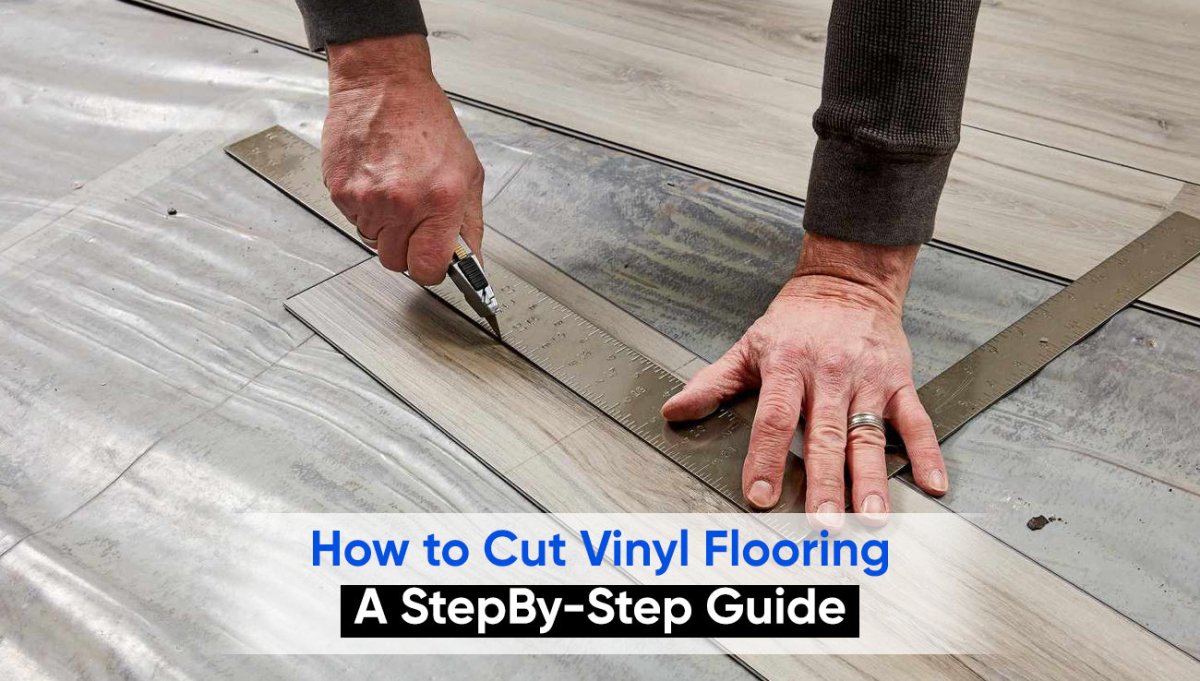If you've never done a DIY project, cutting vinyl plank flooring may seem intimidating, but fear not! You can cut through those sheets or boards like butter if you have the correct equipment and a little know-how. This ‘how to’ guide deals with the best way to cut vinyl plank flooring precisely and securely:
What You’ll Need
Before diving into how to cut vinyl plank flooring, let’s ensure you’ve got everything you need. Here’s your toolkit checklist:
- Measuring Tape: Precision is key, so a reliable measuring tape will be your best friend.
- Utility Knife: A good utility knife can cut Most vinyl sheet flooring.
- Straight Edge: A ruler or a T-square to guide your cuts and keep them sharp and straight.
- Marker/Pencil: To visibly mark where you’ll be cutting.
- Flooring Cutter or Circular Saw: For those thicker, tougher pieces or luxury vinyl planks.
- Safety Gear: Gloves and goggles for protection. Safety first!
How to Cut Vinyl Flooring? A Step-By-Step Process

Step 1: Measure Twice, Cut Once
This ancient proverb from carpentry never fails. To calculate the amount of flooring you need, measure the area that will be covered. Remember to include the area surrounding the borders in your vinyl planks or tiles measurements. Additional material should usually be purchased to account for errors or difficult cutting around fixtures and corners.
Step 2: Mark Your Cutting Lines
Using your straight edge and marker, clearly mark the cutting lines on the vinyl. Ensure the lines are visible and double-check the measurements. A small mistake in measuring can lead to a larger section of wasted material.
Step 3: Scoring and Snapping Vinyl Sheets
If you’re working with vinyl sheets, place your straight edge along the marked line, and use the utility knife to score the material. You don’t need to cut all the way through; a firm, deep score is usually enough. Then, gently bend the vinyl back on itself along the score line, and it should snap cleanly. This method is perfect for quick, straight cuts.
Step 4: Cutting Vinyl Plank Flooring or Tiles
A simple score and snap might not suffice for cutting thick vinyl boards. Here, a flooring cutter or a circular saw comes in handy. Place the plank or tile on a stable platform, align the saw or cutter, and cut along the pre-marked line. It's important to wear protective gear when using power tools. They might release microscopic particles that could get into your lungs or eyes.
Step 5: Test Fit Your Pieces
After cutting, always test fit your pieces in the space where they will be laid. This ensures that they fit and allows you to make minor adjustments if necessary. It’s much easier to trim a little more off than it is to fix a short gap!
Pro Tips to Cut Vinyl Flooring
- Keep Your Blades Sharp: Dull blades can tear the vinyl rather than cut it, leading to jagged edges and a less professional finish.
- Use a Cutting Mat: Protect your tools and surface using a cutting mat, especially utility knives.
- Consider the Pattern: Consider how cuts will affect the layout if your vinyl has a pattern. You might need to adjust to ensure the pattern looks continuous and pleasing once laid out.
Troubleshooting Common Issues
- Tearing: If the vinyl tears during a cut, check if your blade is sharp enough and ensure you’re using the right method for the type of vinyl.
- Mismatched Seams: This can happen if measurements are off or cuts are not straight. Always double-check your measurements and use a guide to ensure straight cuts.
Conclusion
Careful cutting and meticulous planning are essential for a successful flooring project. Don't rush your cuts; take your time and measure well. So, that was it about our comprehensive guide on “how to cut vinyl flooring.” And if you would like to test out some excellent vinyl flooring choices, visit BuildMyPlace.com. And why not arrange a video conference with our professionals if you want more advice?
FREQUENTLY ASKED QUESTIONS
Q: Can I use scissors to cut vinyl flooring?
A: Yes, scissors work well for cutting thin vinyl sheets, especially for trimming little portions or making slight modifications. However, a utility knife, flooring cutter, or saw will yield cleaner, more accurate cuts on larger sheets or boards.
Q: What should I do if my vinyl planks chip when I cut them?
A: If you use too much effort or the blade on your cutting instrument is dull, chipping may happen. Ensure the cutting tool you're using is sharp and suitable for the kind of vinyl plank you're dealing with. Using a laminate flooring-specific blade with power equipment will assist in lessening chipping.
Q: How do I cut vinyl flooring to fit around corners or odd shapes?
A: To cut intricate shapes or around obstacles like pipes or cabinets, make a template of the area using cardboard or paper. Trace the template onto the vinyl and then cut using a utility knife for precision. This method helps maintain accuracy and avoid wastage.
Q: Is it possible to cut vinyl flooring directly over a subfloor?
A: It is not advised to cut vinyl flooring directly on the subfloor, as this might harm the subfloor and the blade. Use a cutting mat or a piece of thick cardboard to safeguard the underlying surface.
Q: How can I ensure my cuts are straight when using a utility knife?
A: Always guide your utility knife with a straight edge or a T-square to achieve straight cuts. If you can't stop the straight edge from shifting while you're cutting, fasten it using clamps. This will enable you to finish with a polished appearance and preserve a straight line.




